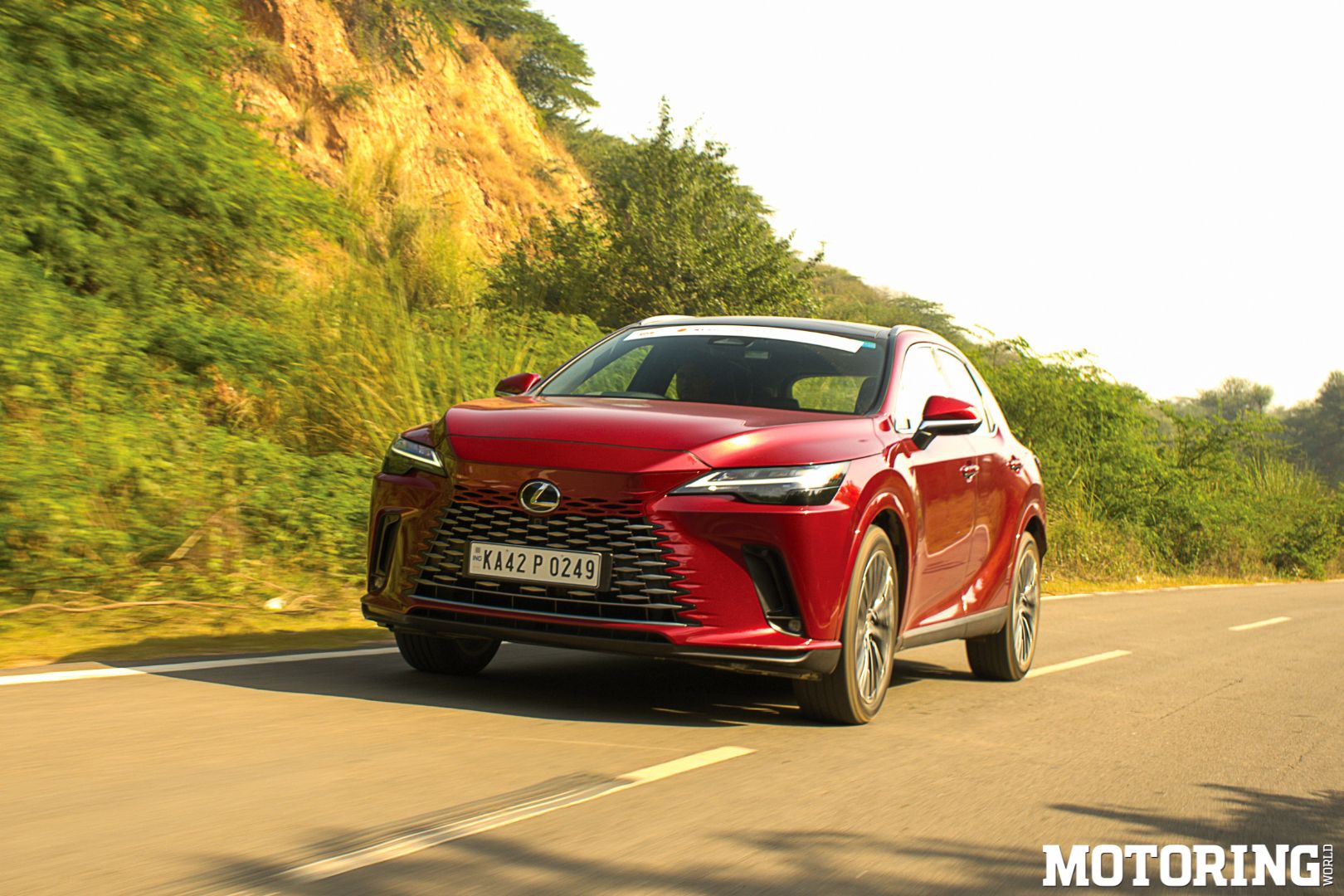I have to admit that when I first saw photographs of the new Lexus RX 350h, I raised an eyebrow. ‘What is it with Lexus and that spindle grille?’ I thought. ‘Surely it’s not necessary to keep extending it till its as long as the car?’ When the car showed up at my doorstep, however, I was forced to reconsider my jaundiced opinion (indeed, I have reconsidered many bile-tinted opinions about Lexus over the past year, as you may have gathered through my recent writings). This is a truly impressive looking car, that’s the truth of it — and at 4,890mm in length, it’s big, which should suit most buyers in this segment very well. The downside of that is that it’s not the easiest thing to park on a narrow Bengaluru by-lane, but when did you last catch Lexus owners parking on the street?
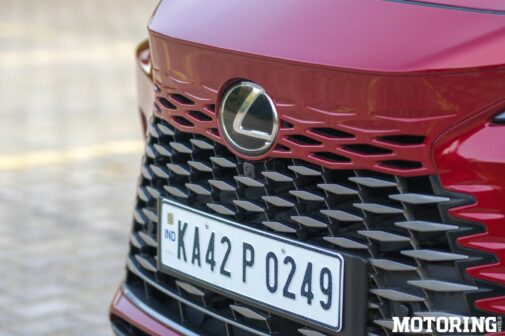
There’s a strong resemblance to the previous RX model, but there’s also many new design bits, beginning with that all-encompassing grille. It looks great in the flesh, and the updated one has a body-coloured top section, with the section below being a black/grey combination that looks like a more conventional trapezoidal grille. The sleek LED headlights accentuate the grille on both sides, and the vents below them round off a bold, striking face.

From its side, this is the best looking SUV in its class, hands down. Something this large doesn’t often qualify as ‘sleek’, but the RX pulls off this feat, with a forward sloping profile, a swooping roofline, integrated spoiler, pinched rear windows and tastefully sculpted doors. The rear windshield slopes slightly outwards and meets the end of the tail lights, which is a nice touch too. The 21-inch alloy wheel design is a bit busy for my liking, but I must admit they complement the car’s profile. The rear isn’t half bad either, with the spindle/trapezoid theme being repeated in the middle of the hatch. The tail light assembly spans the width of the rear, and its flared edges and thinner mid-section play off well against each other; there are cool creases connecting the LED bar to the vents. All told, if you’re looking for a luxury SUV that will immediately stand out from the crowd, the RX presents itself. The amount of attention it got while I was driving it speaks for itself.
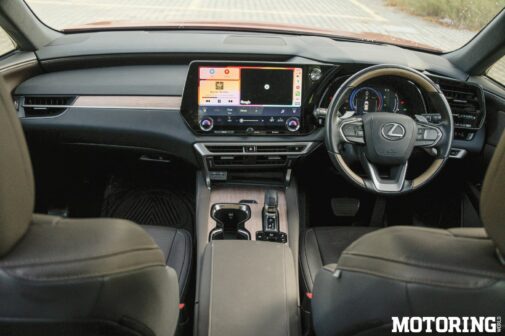
Now, if you’ve been dazzled by a cabin like the one in the off-the-charts LC 500h, you’d be well advised to lower your expectations a bit; it’s very similar to the one in the smaller NX, still extremely well put together and as good as the competition, but it’s nowhere near as special, which is a pity — I think Lexus missed a trick here that could have made the RX truly great. The most significant change is the 14-inch touchscreen infotainment system, which thankfully doesn’t jut out of the dashboard; it replaces the trackpad-based, non-touchscreen infotainment system in previous-gen Lexus models, which is probably the most infuriating piece of automotive technology ever made. The screen’s resolution is great, it’s responsive to the touch and it gets wireless Apple CarPlay (but wired Android Auto, weirdly) — sorted, then. The audio system is a 12-speaker Mark Levinson unit that is absolutely brilliant; concert-hall is an understatement. The twin HVAC dials integrated into the touchscreen are easy to use, too. The instruments are digital and laid out in an easy-to-read manner, and a HUD is present as well (I find these a little distracting and always turn them off).
On the steering wheel, the controls are both touch and pressure-sensitive, which on the face of it is a good idea because different functions are built into the same button; in practice, it’s a bit weird and takes getting used to. I imagine Lexus engineers were miffed by their beloved trackpad being taken away, and decided to avenge themselves by slipping in this new gizmo. According to Lexus, the cabin has been built taking inspiration from Tazuna, the Japanese term for ‘controlling a horse via its reins’. This marketing-speak actually works, because ergonomically the interior is excellent; everything feels like a natural fit, and all the essential controls are within easy reach. The seats are wonderfully supportive and are heated/cooled, and the view on to the road from the driver’s seat is expansive. The rear seats are great, too, and there’s acres of room for four adults; storage spaces abound as well, with the centre console opening on both sides.
The ‘e-latch’ door handles are another neat addition — you have to press the handle inwards with your thumb, which opens the door in one smooth outward motion of your arm. The outer door handles are also e-latch; when you grip them, a button releases the locking mechanism, so you don’t have to pull on the handles. Other features include a three-zone climate control system, a massive sunroof, wireless smartphone charging, a colour HUD, connected car tech, every ADAS feature you could want and a 461-litre boot. Suffice to say that spending long hours inside this car will be a very pleasant experiencing.
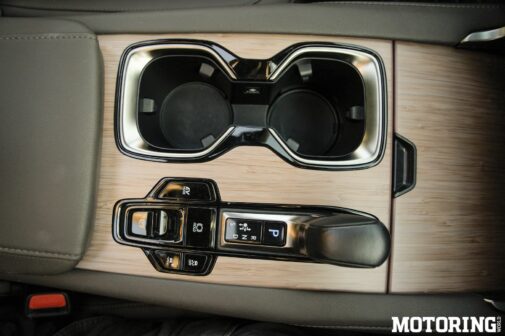
With a relatively tiny 2.4-litre, 4-pot motor under its huge hood, the strong-hybrid RX has access to a combined 247 bhp and 32 kgm of torque; it’s no rocket, as you may have guessed. The emphasis is on a relaxed, fuss-free driving experience (like in all Lexii) and that’s exactly what it offers. Given its near-two tonne kerb weight, it’s a little slow off the line, but keep the throttle mashed and the build up is linear, with a 0-100 kph time of a quite respectable 8 seconds. The 8-speed e-CVT transmission, with an overdrive, pairs well with the engine, but it isn’t energetic (which CVT is, pray tell?); quick acceleration needs a proper bash of the loud pedal. Besides, if more shove is your jam, you could always get the RX 500h, which has a slightly smaller capacity engine, but which makes a combined 268 bhp and 47 kgm. Lexus knows hybrids inside, out, forwards and backwards, so unsurprisingly the powertrain’s calibration is superb; at low speeds, the petrol engine is barely used, thanks to the presence of the battery and twin electric motors. Full EV driving is also possible, but with an extremely light foot.
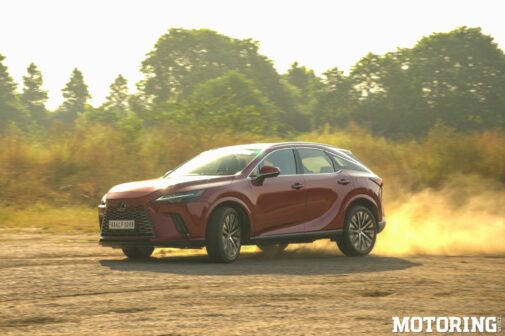
If you want to spice things up a bit, there’s always Sport and Sport+ mode which, in combination with the paddle shifters, throws more entertainment into the mix, since you can hold revs for longer. My experience was that it’s best to just slot this car into D and go, without messing around with modes. The one rather surprising downside is that this engine is oddly loud during hard acceleration, for a Lexus; overall refinement and NVH levels are of a high order, otherwise. Besides, when you realise that the RX is returning between 12 and 15 kpl, you most likely will forgive it its minor niggles; its 65-litre tank will take give you about 900 km of range, which is impressive.
As I mentioned earlier, a full array of active and passive safety features are on board — adaptive cruise control (which works brilliantly), pre-collision detection, lane departure alert, lane tracing assist, blind spot monitoring, brake assist, VSC, 7 airbags and several others. Some of these are a little aggressive in nature, especially in Indian driving conditions, but better safe than sorry, I suppose. The previous-gen RX got a 5-star E-NCAP rating, so there’s no reason to believe that the new model isn’t as crashworthy. By all accounts (I haven’t driven it), the older RX was a bit of a bar of soap in the handling department, and it didn’t ride that well either. Lexus must have really gone to town with the new multi-link suspension, then, because this model has a very polished feel to it in both departments.
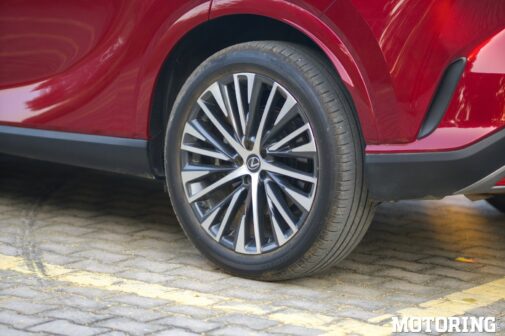
Again, that ‘relaxed’ word comes into play, but it’s not lazy by any means; in fact, for such a large car, grip and body control through a series of fast corners are very impressive. Even with those huge 21-inch wheels, the ride quality is polished and superbly settled, with only the occasional thud or bump making itself felt; with 189 mm of ground clearance, you won’t have to worry about scraping its underbelly. The steering wheel feels good in your hands, is well-weighted and smooth to operate, and the brakes are on the ball all the time, although some more feedback through the pedal would have been welcome.

Like everything Lexus makes (with the glorious exception of the LC 500h), the RX is a classic head vs heart car. All its cars are built for a degree of reliability that its rivals usually can’t match, and the firm seems to be happy to cater to buyers that want a refined, premium product that won’t make them go to a service centre too often. On the flip side, its cars aren’t the first to pop into an enthusiast’s mind, but again, Lexus seems to want to keep its existing customer base happy. A Lexus owner will feel right at home in the RX, but a first-time buyer may look askance at the lack of electronic whizbangs in the cabin; which side of that divide you’re on will determine whether you loosen your purse strings for this car. As someone whose loose purse will produce only a stray coin or two (but who has driven everything in this class), I can only say that if I had to put down over a crore of rupees for my luxe SUV, I’d certainly be wiring that money to Lexus.
Photos shot by Rishabh Nagi





